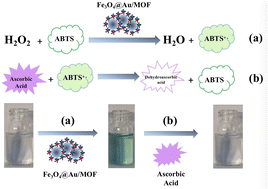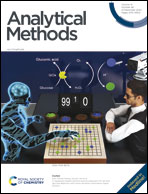Fe3O4@Au–metal organic framework nanozyme with peroxidase-like activity and its application for colorimetric ascorbic acid detection
Abstract
A free radical scavenging system based on Fe3O4@Au/MOF-ABTS˙+ has formed the basis of a novel method for the highly sensitive and specific spectrophotometric determination of ascorbic acid (AA). The Fe3O4@Au/MOF nanozyme with magnetic separation properties was effectively prepared and evaluated using an environmentally friendly technique. Nanomaterials have the advantages of superparamagnetism, biocompatibility, chemical stability, and enhanced synergistic peroxidase-like activity, which can be utilized in catalysis to oxidise the peroxidase substrate 2,2′-azino-bis(3-ethylbenzthiazoline-6-sulfonic acid) (ABTS) into a green-colored product in the presence of H2O2. AA as an antioxidant has scavenging effects on ABTS radicals and can reduce green ABTS˙+ to uncolored ABTS2−, contributing to a substantial reduction in green color. Based on such a premise, a highly selective and sensitive chromogenic sensing method depending on the peroxidase-like activity of the nanocomposites was developed in order to achieve the efficient detection of AA in real samples. Under optimum conditions, the proposed technique had a detection range of 0.001–0.1 mmol L−1, a limit of detection of 0.098 μmol L−1, and a detection time of only 30 seconds. The newly proposed colorimetric analysis method devoid of enzymes has broad application potential in the areas of quality control and quality and safety detection.



 Please wait while we load your content...
Please wait while we load your content...